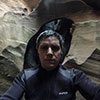Results 1 to 15 of 15
Thread: How many CFS is this?
-
01-10-2013, 07:29 PM #1
How many CFS is this?
A caver friend and I are looking at doing Kolob this summer. Tom's site warns of no more than 5cfs for that canyon. Duly noted. We know to check the release schedule. But we show up, how do you guess what the CFS there in the flesh. Say the damn changed schedule or something.
So help us out. Can you guesstimate the CFS in this video? We have no clue. This is a 45ft drop in a cave in Alabama we did at the end of December. And if you liked getting punched if they face with waterfalls like we do, come caving in Alabama in the winter. Good stuff.
Alternate View:
Edit: Adding in Jbartlett's video
-
01-10-2013 07:29 PM # ADS
-
01-10-2013, 07:40 PM #2
For your estimating pleasure, here is an alternate view of the same pitch with me climbing a minute or two later, taken from another camera. Obviously, this isn't a scientific process, but we're looking for a decent reference point before we make the leap from 3B/4B canyons to 3C.
(edit: crap, it won't let me post the youtube link -- Kyle, can you post it for me?)
It's also worth noting that this water is between 56 and 58 degrees. We're wearing 3mm farmer john wetsuits beneath coveralls.
-
01-10-2013, 08:26 PM #3
No scuba gear but it looks real wet in there. If I found that kind of flow at the head of Kolob, I think I would doing Boundary instead.
Cool video.
My guess is 15 cfs. There is software out there that one can use to actually calculate an estimate of flow using video and particle image velocimetry. Open source software is available for this purpose. This methodology was used to estimate oil leakage from the Deepwater Horizon well oil spill that occurred April 20 ,2010 in the Gulf to fine the crap out of BP. Using the right software, and knowing the approximate diameter of the climbing helmet, an engineering buddy, and about 100 hours, you can prove me wrong.
Ken
-
01-10-2013, 10:47 PM #4
How many CFS is this?
15 seems pretty high to me. I've done Kolob several times and basing what we see off of what we were told the flow was, we guessed it to be in the neighborhood of 3 on the flowiest day. Tripling that would more than give you what is in that vid.
My opinion is that the flow in the vid does not exceed 10cfs. I've done imlay with a flow greater than what I've done in Kolob and just a hair under what is seen in that vid.
-
Post Thanks / Like - 1 Likes
 JBartlett liked this post
JBartlett liked this post
-
01-10-2013, 11:22 PM #5
I would check this post out for CFS info
http://www.bogley.com/forum/showthread.php?66705-CFS
The biggest thing for me would be trying to compare what the flow looks like in a video with flow when you are out in a canyon. I tend to always error on the side of safety in my pursuits. If one or two CFS means the difference between a fun day and disaster I would want a better method of gauging flow.
-
01-11-2013, 05:07 AM #6
What's interesting is that, in the case of Kolob, Tom provides some very specific guidelines for when NOT to go for it -- "Flows of 3-5 cfs will prove challenging to most canyoneers. Flows above 5 cfs are too high to safely descend the canyon" -- and you can call to find the dam schedule. So there's a pretty decent way of checking whether the canyon can be attempted.
But that leaves two questions unanswered for us, hence the existence of this thread.
First, let's say the flow is 3-4 CFS. Based on our experience on rope in powerful waterfalls, and your responses in this thread, it sounds like rappelling waterfalls with that type of flow will be well within our skillset. Heck, we won't even have to climb back up them like usual! But that's what we're looking to confirm: that, for our small group of expert cavers, the difference between 2 CFS and 4CFS isn't going to ruin the trip.
Second, since we never deal with CFS in our primary sport, we just don't know how to estimate it by sight. This removes one of the safety checks Tom recommends; after all, how would we know to turn back if we see a flow in Kolob Creek below Kolob Terrace Road above 5 CFS, when we don't know what 5 CFS looks like? So we're trying to create a crude baseline here. I posed this same question on Facebook and have had answers ranging from 1 CFS to 10 CFS, so obviously this is an inexact science.
For the record, the flow in the above videos is relatively atypical; this may be the most water I've rappelled and climbed through in a multi-pitch cave, to date. I don't know that I'd be interested in attempting my first 3C canyon with that much water going through it, whether or not that's an achievable goal... and in the instance of Kolob, we know for certain it is not. But I'd estimate 50% of that flow is VERY typical, and a non-issue.
By the way, what's the limiting factor in Kolob when the flow is over 5 CFS? The way the beta is written, it sounds like there is some obstacle that makes the canyon impossible, beyond the waterfall rappels themselves being too hairy.
-
01-11-2013, 08:56 AM #7
A cubic foot of water is just under a gallon in volume? Given the size of the flow, the volume looks like the caver is seeing a few gallons of water pass by every second?
My guess is 2-3-ish?
Tough thing to estimate!
-
01-11-2013, 09:01 AM #8
Flow is a tough thing to estimate. Kinda frightening. Or not. Dunno. This was deemed too high for most folks, and, the hydraulics weren't too bad (whatever that means). Pool at the bottom was fairly shallow, reversal wasn't too strong, and, swimming out was super hard, but, the wall could be used to get by the flow.
In Kolob, you're in a tight, confined canyon and the hydraulics would be super gnarly and really hard to manage. You can't just pull out to the side and think about things. You'd be in it. Hard to manage rope, and, hard to manage staying above the water to breathe, and hard to not get beat up pretty badly.
You can kinda guess, but, I know my eyeballs just aren't calibrated to know what is semi safe and what is foolish.
In the canyon above, it had been raining hard and we continued as we'd heard it didn't flash. The flow trippled at least. We all ended up bailing out of the canyon downstream but for a while it was a bit sporty. No one died. Folks do die in high flow. How much is ok? So hard to estimate.Last edited by Brian in SLC; 01-11-2013 at 09:06 AM. Reason: add verbiage
-
01-11-2013, 09:23 AM #9
-
01-11-2013, 10:30 AM #10
-
01-11-2013, 11:15 AM #11
It's complicated.
1. The ACTUAL Flow: The Water District sets the outflow on the Dam above the canyon. They do so by eye - it is not very scientific. Their normal maintenance flow is stated as 3-5 cfs, and some guy (or gal) goes out there and spins open the gate until it looks right. I have done Kolob 3 times (at least) when it was at "3-5 cfs" and there was more than a 2:1 difference in flow. The high flow I called 8 cfs. But my personal gauge in this canyon is 'calibrated' by considering the low end of the 3-5 cfs as "3" and the high end as "5", disregarding the high-outlier as "8". (Conclusion: NO SCIENCE here, its all guesses and approximations.)
2. What they release from the dam is not what is in the canyon. Sometimes it is more, sometimes less.
3. When the Water District is releasing more than 5 cfs, they usually release quite a bit more, like 15 cfs. In that canyon, 15cfs is a LOT of water. When the Water District is releasing more than 5 cfs, Zion NP will not give you a permit.
4. There are three main problems with high water in Kolob:
4A. Pinch Points: there are places where all the water funnels through a narrow place in the canyon (say, 2 feet wide). Oh, and to descend the canyon, you will need to be in that place too, and under control, on rope, because there is a significant dropoff just below this. Very difficult, very dangerous;
4B. Getting to anchors: the anchors in Kolob are positioned for low-water conditions. Some of the anchors could be really difficult to get to, with high flow. In some instances a belay could be set up... but what about the last person? Some canyons in Europe, done in high flow, have drilled anchors placed just for high flow conditions, to keep people out of the flow when being in the flow is dangerous. Kolob does not have these types of anchors.
4C. At the base of some of the waterfalls (that are rappelled), there are swirling hydraulics that can be very dangerous. Send Brian Cabe first! This is what killed the two Youth Group leaders in 1993. Wearing a helmet might have helped them - but maybe not.
5. My concern with medium water flow (8cfs) is that it takes precise Class-C ropework skills to get down the canyon safely and get your ropes back. My thought while pulling the rope at the first big rappel was, if the rope got stuck in the pool part way down, then we were screwed. Spending the night in the canyon would not have worked out so well. Thus, I think it wise to carry at least one extra rope in Kolob. And to be very good in your ropework. And to be lucky. It may be helpful to know that there are only two long rappels in Kolob, and if you get only one rope back from the first long rap, you can still get out of the canyon (assuming the two short raps below the last big rap are jumpable (usually are)).
6. In conclusion - when you get to the first rappel and see the actual flow in the canyon, consider whether you can stand on rappel with that entire flow landing in your lap. If yes - have a great day. If not - go do Boundary.
Check this out: http://www.canyoneeringusa.com/rave/1007kolob/
Tom
-
Post Thanks / Like - 2 Likes
-
01-11-2013, 01:56 PM #12
WOW. That is a tremendous amount of excellent, detailed information. Thank you, profusely.
Things that come to mind in reply, randomly, below.
Re: Anchors being impossible to reach
That's an excellent point. In many caves, where we are most often rigging fixed ropes we plan to ascend back up as we exit the cave, finding an extra bolt for a traverse line approaching an edge is very common (though not common enough). In other instances, one of the bolts will be set further back than one might imagine, so that the drop may be rigged in such a way for the approaching rappeller to clip a cowstail into the Y-hang itself.
Here is an example, where the bolt pair has been rigged with an eight-on-a-bight and alpine butterfly; at the beginning of the video you can see the next caver in line clip into it with a safety line. http://www.youtube.com/watch?v=cTq_azIlrgI
Re: Significant hydraulics
This actually scares me more than anything, because -- while I feel quite comfortable rappelling through waterfalls -- I am not a very strong swimmer at all. Which is to say that I can float and flail my way through swimming sections of caves and canyons in all my gear, but I don't want to have to fight a serious current while swimming.
Re: Helmets, etc
One thing that probably stands out in this thread is the fundamental message: "We are experienced cavers and we want to make the move from 3B canyons to 3C canyons." In very much the same light, the hair stands up on the back of my neck when I hear people say "We are experienced climbers, so we can totally handle [insert cave name here]." They're different sports, with different technical challenges and different kinds of problem-solving. So it might be worth elaborating a bit.
First, on the safety side of things, we don't take canyoneering lightly. We all wear helmets, with headlamps. Due to our familiarity with caving techniques, we rappel with micro-racks and are wearing our frog ascending systems on rappel. We all wear gloves, appropriate footwear, kneepads (force of habit) and wetsuits (well, I like to also wear a wetsuit jacket because I'm cold-natured, and for Kolob in late June I dare say I'd consider renting a drysuit from ZAC). Everyone has a pack with their own emergency gear. We use appropriate, static canyoneering ropes (on this trip we're likely to have two long lengths of 8mm Bluewater Canyon Pro). We tell someone where we are going and when we should be back. We primarily do our pull-downs using a clove hitch + carabiner blocker knot. And, as you've advised, we always carry extra rope(s), without question. And a bajillion pieces of webbing, and quicklinks, and the components of a 3:1 "Z rig."
Second, while a few of our party are relatively inexperienced with canyoneering -- for example, I've only done a half dozen canyons, although I might lobby to include another half-dozen caves which are done as "through trips" with pull-down rappels and nearly identical techniques -- Kyle has completed several dozen in Zion and elsewhere, and our companion has completed hundreds. None have done Kolob, but we think it's time.
You know, in case anyone sees this thread and thinks we're likely to kill ourselves.
Not to say it isn't possible for us to kill ourselves... it's just not LIKELY. :)
Re: The link and attached image
Holy crap. So, even if Zion NP gives us a permit (implying <5 CFS reported from the dam), don't do Kolob if it looks anything at all like that. Got it!!Last edited by JBartlett; 01-11-2013 at 01:58 PM. Reason: Clarification
-
01-14-2013, 07:54 AM #13
I'd thought that the basic rule of thumb was that if you can't hear someone yelling from the bottom of the first rap (when you're still at the top) then you shouldn't do it. Once again, not an exact science, but something that's a pretty fair test right when you're there.
--Cliff
-
01-16-2013, 01:34 PM #14
-
01-16-2013, 05:22 PM #15
Great points there Tom! Yikes, can't imagine doing Kolob in a high flow. That last rap anchor is a small stretch around the corner, and slippery.
Interesting that some in Europe put high anchor points to avoid the flow. Much safer than the last person who belayed everyone gets to "flow down" and being caught by the 2nd to last person on the anchor...
-
Post Thanks / Like - 1 Likes
 ratagonia liked this post
ratagonia liked this post
Visitors found this page by searching for:
Outdoor Forum





 Reply With Quote
Reply With Quote










